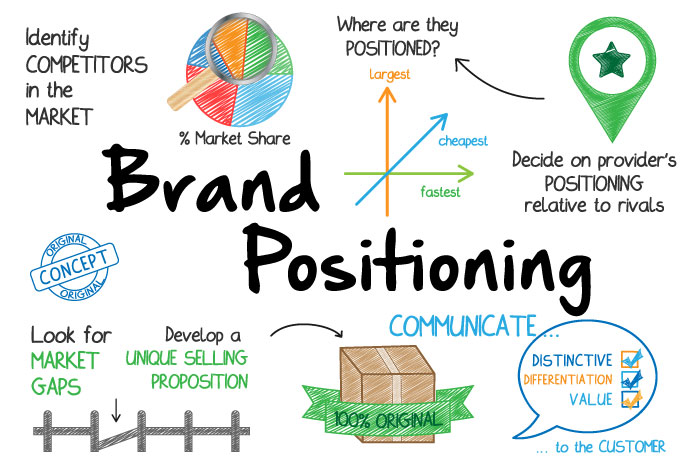7 Steps to Developing a Powerful Brand Positioning Statement
7 Steps to Developing a Powerful Brand Positioning Statement
‘Nobody buys a product or service because it can do everything, but rather because it can do something’ – Tim Williams’ Positioning for Professionals
Why no one will ever say ‘Yahoo it’ or ‘Bing it,’ but always ‘Google it’?
Why don’t kids want to go to a ‘fast food restaurant,’ but to a McDonald’s?
Does no one care about Pepsi despite hundreds of taste tests proving that it tastes better than Cola?
You can read more about these taste tests from Pepsi here.
How did these brands, often not delivering the best quality in their segment, become a synonym of the product or service they provide?
In this post, we talk about how businesses use brand positioning to define their place in the marketplace.
This goes back to the core marketing concept of brand positioning.

Image Source: Outside-The-Box
Brand Positioning
Initially, at first glance, people consider brand positioning as a form of product differentiation.
However, there are two key positioning concepts that businesses must consider; company positioning (image) and positioning within a consumer’s mind.
This blog is more specifically about the latter strategy for brands to employ when developing their marketing strategy.
A marketing strategy that suggests finding something that differentiates your product/service.
It especially differentiates from your competitors and uses that something to embed your brand in a particular place of your customer’s mind.
So, where your product sits in terms of value offered vs. the competitors in the market?
As easy as that sounds, unfortunately, mind control has not yet been invented.
Even if it was, it would probably be illegal (we certainly hope so).
You can control your brand’s place in the market, but not in your customer’s mind.
Thus, brand positioning can only aim to fill in a certain spot, to occupy a unique, clear, and beneficial position in the costumer’s minds.
In our digital age, where the internet is in everyone’s pocket, brand positions are established very early on.
We talk about first impressions and why a need to take advantage of having a robust web presence in our earlier blog Reasons for a Website in Today’s World.
One of the most influential marketing thinkers, David Ogilvy, said:
While many people argue on the definition of brand positioning, it can be summarized as to what a product does and who it is for.
Brand Positioning is not only different from your brand’s tagline or mission statement; this determines them.
It begins the moment someone is introduced to your brand.
This is an ongoing relationship that develops with every touchpoint, such as advertising, customer interactions, and product/service usage.
That is why it is critical that your business spends a sufficient amount of time in creating a positioning strategy and the most important part of it – a brand positioning statement.
In Crossing the Chasm (a must-read book for small businesses or early start-ups), Geoffrey outlined the essential elements of creating a brand positioning statement.
He proposes to outline the target customer and their need.
How and why your product/service will benefit the said customer and need, then to put your advantage against a competitive alternative.
To better understand how to define your target customer – go to our earlier blog post on the fundamentals of marketing.
It is questionable, whether opposing a competitor is necessary for creating your positioning statement as it is better to grow the market, rather than concentrate on competition.
Winners win, and competitors battle for second place.

Image Source: Ts-Advertising
7 Steps to Developing a Brand Position Statement
Source: Feedough
The below steps are after that your brand has been or out in the marketplace.
If you are an existing brand, you understand that marketing strategy is the way to serve your customer’s needs effectively.
Thus, researching and reassessing your brand positioning is essential for commercial success.
This is how we recommend you go about doing it:
Identify your current category.
For example, to separate your energy drink from other soft drinks, start with the customer.
Who are they, why do they like your product, what do they do with it, and why do they buy it?
Determine your current positioning in the market
Even if positioning has not been purposefully established, or done incorrectly, customers will still have perceptions of your brand.
To understand current positioning, talk to the customers, read the reviews, or monitor social media.
Select and narrow down your key competitors to compare your brand against
Think about not only your direct competition but indirect competition.
If customers are not going to buy your product or service, what else could they buy, which will fulfill their needs?
Going back to the soft-drink example, If they do not buy your soft drink, could they get the same utility out of bottled water?
Try your best to assess your key competitor’s positioning in the market.
What is special about your competition’s brand, and how can they win your clients over?
What are they offering that you are not?
Note here that you shouldn’t aim to replicate them, just be aware of what they are doing.
Now do the analysis and review (your brand vs. your competitors)
Compare your and your competitor’s positioning.
To do this, think about Points of parity (POPs) and points of differentiation (PODs).
POPs are how what you are offering is similar to the competitor’s offerings, with PODs being the opposite, how your product is different.
You can read more about a great summary put together by the Segmentation Study Guide.
In your review, take time also to identify your uniqueness and strengths.
Coming from the previous point.
Your PODs will be the ones written below;
- Identifying your strengths.
- Taking advantage of strength in your messaging.
- Copywriting.
- Brand communication.
- Develop a new positioning statement and strategy.
Building on everything you learned from your research, develop a positioning statement that will reflect your desired brand positioning.
Reflecting on your marketing plan, create a new brand strategy that will bring you to your goal market positioning.
Does Not Matter When the Brand Enters the Market
Although the previous points are relevant to you, if you are just entering the market with a new brand/product, you have the opportunity to create a new category in the customers’ minds.
You can enter an existing market and take it by storm, avoiding the mistakes of your predecessors.
Although finding a market gap and creating a new category is not easy, a first-mover advantage gives you a lot of benefits.
Some of them are having few opponents, low cost for customer acquisition, you are hard to catch up with, and whatever comes next is compared with you.
And even competitors that enter the market broaden and mature it, bringing more customers and higher revenue.
Remember that a new market category is not the same as creating a solely new product.
Let’s take the example of Red Bull – many soft drink companies (Coca-Cola, Pepsi, and Lucozade (UK)) marketed themselves as awakening or energy-boosting.
Still, none of them created ‘energy drinks’ for American and European markets.
Creating a new category, Red Bull had the first movers advantage, used it well, and now owns more than 40% of the world’s energy drink market as published on Time.com.
Although a sufficient amount of marketing research insists that the first movers’ advantage is the only way to secure a place in the customer’s mind, this statement is far from being true.
Think of giants like Target, Google, and South-West Airlines, none of them came first.
As John Birger’s former Fortunes senior writer effectively shows in the article Second-Mover Advantage by observing first movers in the market.
The brands that follow and enter the market as second or even third movers can still capitalize on the market by learning from the mistakes of the first movers.
There are too many successful cases of brands entering the market later, but still achieving tremendous success.
Some notable examples that come to mind are Google, Nike & even Apple.
The challenge here is to, although diving into a new category, become a Facebook to someone’s Myspace, rather than a red fidget spinner to a blue one.
Choose a thriving category, find the big demand that is not yet fulfilled, and show your customer that you are outstanding, rather than a duplicate.
By being a market follower, you learn from others’ mistakes and enter a mature market (points of parity are accepted and established within the market).
The incumbent becomes complacent and sees where innovation is needed.
You can go in the right direction and be more flexible.
Some companies are both FMA or MF.
Brand Positioning Statement is for Internal Use Only
Positioning exists to guide marketing strategy and to mediate decision-making.
It is important to remember that brand positioning arises regardless of whether your brand is consciously working on a positioning strategy or not.
Effective brand positioning and branding, in general, take a long time to establish in the marketplace.
Taglines may change from time to time, but your key message will remain the same after you develop this statement.
A key thing here is that this positioning statement is a very internal guide for your business to leverage.
This statement and analysis will help you when you are lost in your brand placement and need to make decisions.
The points below will act as a guide for your team when developing any campaign for your brands:
- Doing the analysis.
- Understanding your place in the market.
- Coming up with a statement.
In doing this research, you are deriving and coming up with competitive intelligence that is unique to your brand and company.
It should be confidential and closely guarded to ensure you maintain your competitive edge.
You should develop your brand strategy with respect to the following considerations.
The considerations are points of differentiation, points of parity, strengths, and uniqueness.
This way, you will use this statement as an internal guide to map out your other marketing efforts.
Over To You…
Brand positioning is a happy medium between internal capability and customer needs and wants. Focus on the customer. Define those pain points in detail!
By points, we mean the points of differentiation in your brand positioning, and then over-deliver at every touchpoint.
With this approach, becoming the market leader in your target category becomes a lot easier.
Becoming a market leader does not happen over time. You have to deliver and over-deliver on those pain points that your customers are frustrated from. There are rarely any overnight sensations. Do you think Netflix was an overnight sensation? How about Amazon? They all struggled initially but were committed to sticking it out and delivering on their brand promise.
To recap, brand positioning is not vital to selling your stuff to a random customer.
If you come to the market intending to be the best in your client’s mind and to maximize your profitability – your chances of success increase.
You would need to invest in creating a solid, professionally thought-through brand positioning strategy.
A great positioning strategy requires sufficient research and analysis performed by qualified marketing professionals.
Spending time assessing your brand, and leveraging analytics, we will work with you to derive a custom brand positioning statement.
Head over to the Digital Branding section of our website to learn more about how and where can help.
Here at Web Worx Labs, we will put together a new, evidence-based, rock-hard brand positioning strategy that will work for you.
Wherever you are in the process of establishing your positioning strategy, turn to Web Worx Labs to have a professional dialogue on the ways you can improve your brand and grow your competitive edge.
